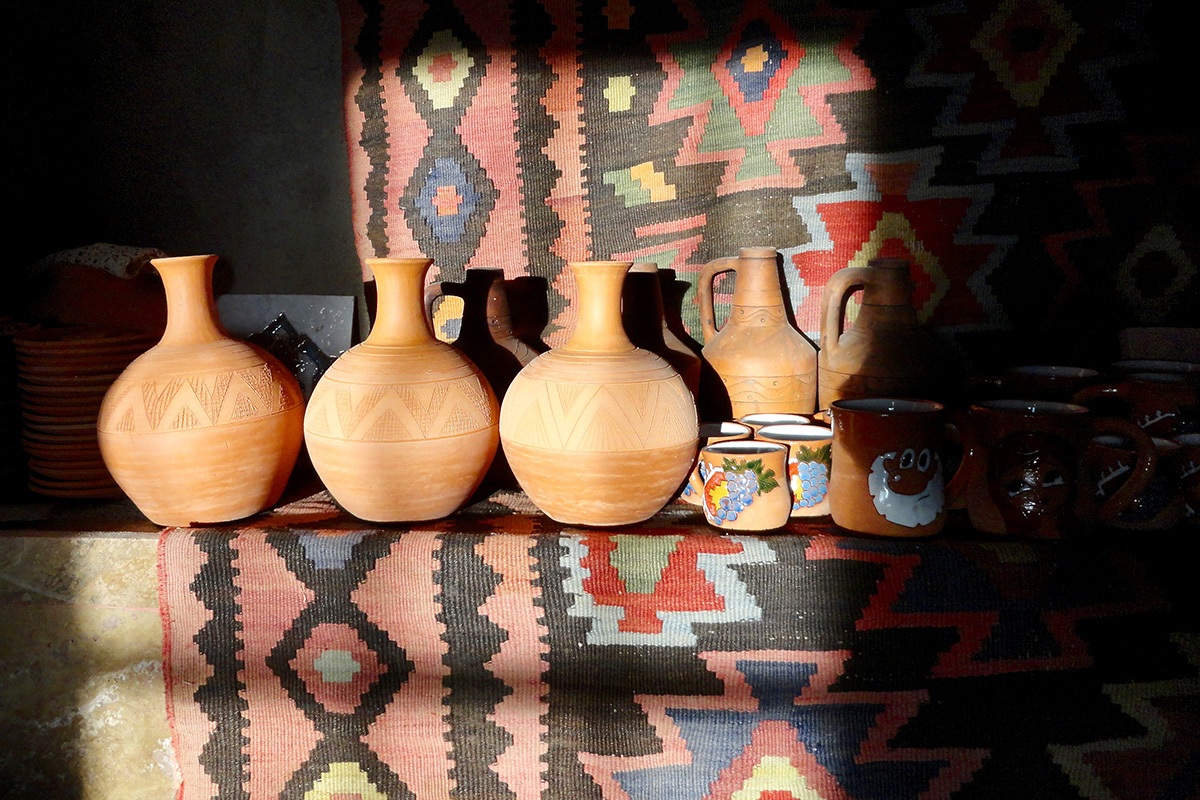The Art of Armenian Pottery:
A Spotlight on Sisian Ceramics

Armenians have been turning clay into useful forms since the third millennium BCE. Large vessels used to carry water, keep preserved foods, and store wine were found in the ruins of ancient dwellings. Etched or painted onto many of these terracotta household necessities were images from the natural world, such as deer, fish, trees, and the sun, as well as images from their mythological world, like dragons and serpents. These images reflect the lush and, at the same time, rugged landscape of Armenia. Pottery continues to be widely practiced today, with many designs still rooted in the traditional forms and cultural motifs of early Armenia.
In November 2017, I had the opportunity to meet two artisans sustaining this tradition and introducing their own distinctive ceramic arts while conducting field work for this summer’s Folklife Festival Marketplace. Vahagn Hambardzumyan and Zara Gasparyan are the husband-and-wife team behind Sisian Ceramics. Founded in 2010, the studio they named for their hometown is located in Armenia’s Syunik Province, a mountainous region located approximately 150 miles southeast of the capital city of Yerevan.
Here, in their cozy, pottery-packed studio, Vahagn shapes from the local clay traditional forms that store wine, water, and salt onto which Zara meticulously etches lines in patterns suggesting wheat, sheep, and the sun. In addition to clay, they source natural materials like beeswax, fat, and milk, using them to glaze and finish their products.

-
Vahagn Hambardzumyan uses a tool to carve earth from his land to use in his ceramics.Photo by Narek Harutyunyan, Smithsonian
-
Vahagn prepares the clay in the Sisian Ceramics studio.Photo by Narek Harutyunyan, Smithsonian
-
Vahagn works on his wheel, keeping his piece damp.Photo by Narek Harutyunyan, Smithsonian
-
The Sisian Ceramics studio is lined with finished pieces and works in progress.Photo by Narek Harutyunyan, Smithsonian
-
Zara Gasparyan works with special tools to add finishing touches to a batik scarf.Photo by Narek Harutyunyan, Smithsonian
-
Zara etches a pattern into a ceramic medallion.Photo by Narek Harutyunyan, Smithsonian
-
A selection of glazes wait for their turn to finish the pottery.Photo by Narek Harutyunyan, Smithsonian
-
Vahagn teaches his daughter how to use the wheel in his studio.Photo by Narek Harutyunyan, Smithsonian
-
Visitors choose from ceramics of all shapes and sizes from their studio shelves. Red tea cups feature sheep, flowers, and foliage as decoration.Photo by Narek Harutyunyan, Smithsonian
-
Traditionally these pots resided in the kitchen to store salt and were one to three feet high and painted to represent a pregnant woman. As kitchens have decreased in size, so have the jars.Photo by Narek Harutyunyan, Smithsonian
-
Cups marked with their Sisian Ceramics name wait for a final firing in the kiln.Photo by Jackie Pangelinan, Smithsonian
-
It is not only pottery that is baked in their kiln. These kiln-baked potatoes were part of a delicious lunch prepared for the team’s field work.Photo by Jackie Pangelinan, Smithsonian
-
Jewelry and pottery share shelf space in their studio.Photo by Narek Harutyunyan, Smithsonian
-
Finished jewelry pieces by Zara rest in one of their ceramic bowls. These are often purchased by visitors to their studio.Photo by Narek Harutyunyan, Smithsonian
Click on the image above to see the process and products of Sisian Ceramics
During my time with Zara and Vahagn, I felt that we were sitting at two makers’ creative crossroads—their past and present influences, their skills as both artists and artisans, colliding in one earthy, warm space. Terracotta pots in the shape of traditional rounded wine barrels, or karas, stand in a line ready for the next finishing step. Trays of round earth-colored cups recently etched with “Sisian Ceramics” shine in contrast to the red, black, blue, and green jewel-toned carpet faded with age.
Next to these heritage pieces, small clay shapes have been decoratively etched, attached to leather cording—older ideas adapted to new jewelry designs. Zara paints creative organic forms on stretched silk “canvases” to become wearable scarves. Studio visitors unable to carry home a karas can bring home Sisian Ceramics artistic expression and cultural identity in necklaces, scarves, and smaller ceramic pieces.
As the visit ended and I stood outside their studio door, my eyes panned the layered landscape: green shades of bushes and grassland led to sepia and beige-toned buildings and further on to vast green hills. In the distance, my eyes rested on the white-capped mountains. It took me a moment to realize this expansive panorama was not on a computer or iPhone screen but the beautiful, and very much real, world. This landscape was the very same view from which their ancestors drew inspiration.
As I breathed it in, it was easy to understand why this commanding landscape is infused in so much of Armenia’s artistic heritage, continuing to inspire artisans from the beginning of Armenia to the traditional and innovative work of Zara and Vahagn.

Visit the 2018 Smithsonian Folklife Festival June 27 to July 8 to meet Zara and Vahagn and learn more about their ceramic arts. Their pottery and jewelry will also be offered for sale in the Festival Marketplace located in front of the National Museum of American History during the Folklife Festival.
Jackie Flanagan Pangelinan is the Marketplace and artisan engagement manager for the Smithsonian Folklife Festival.














